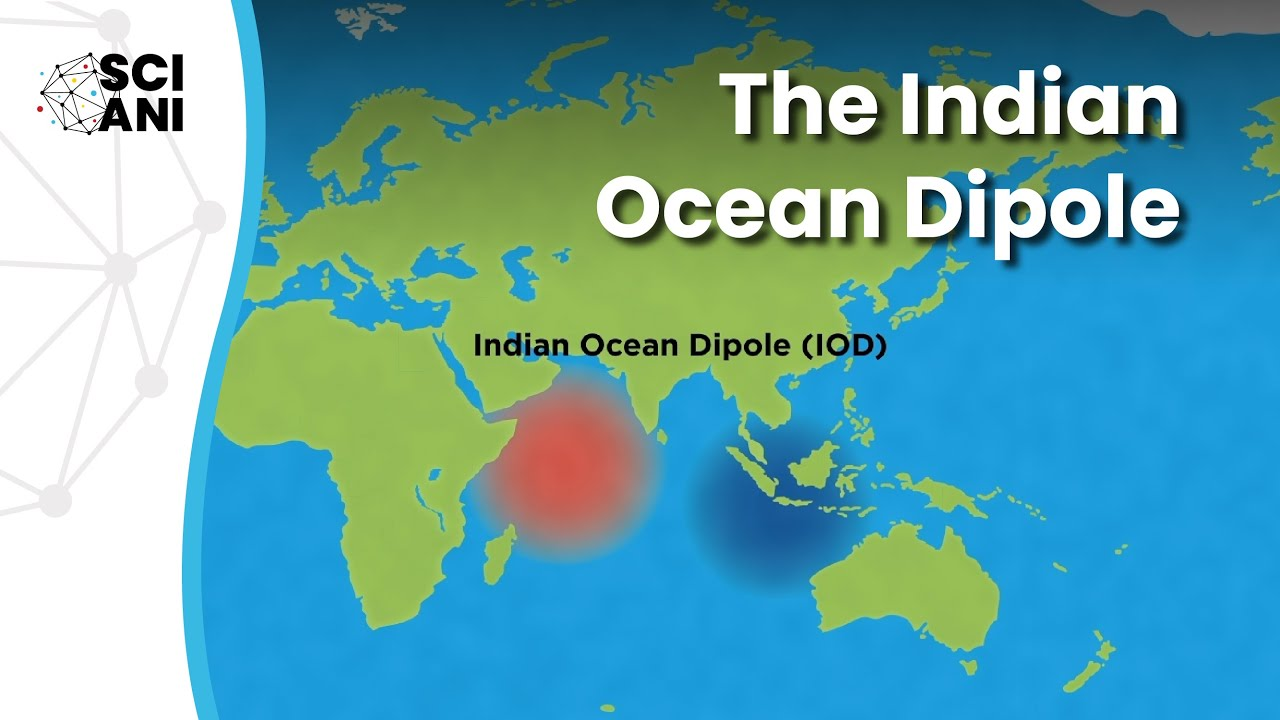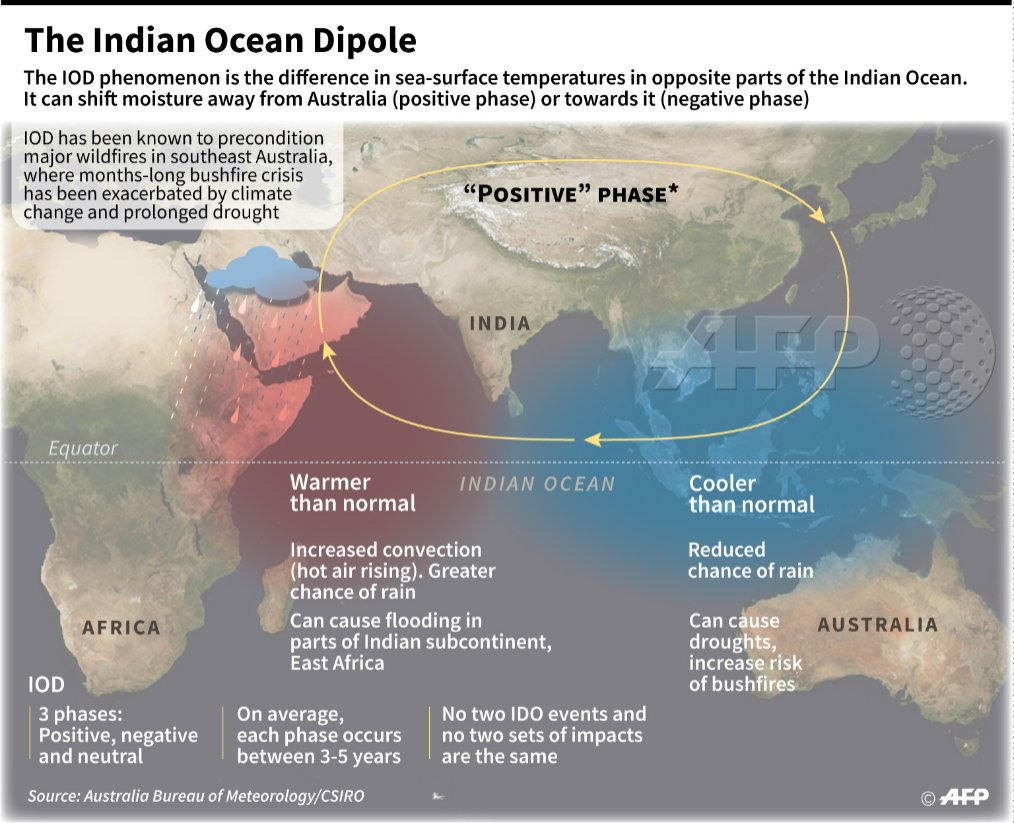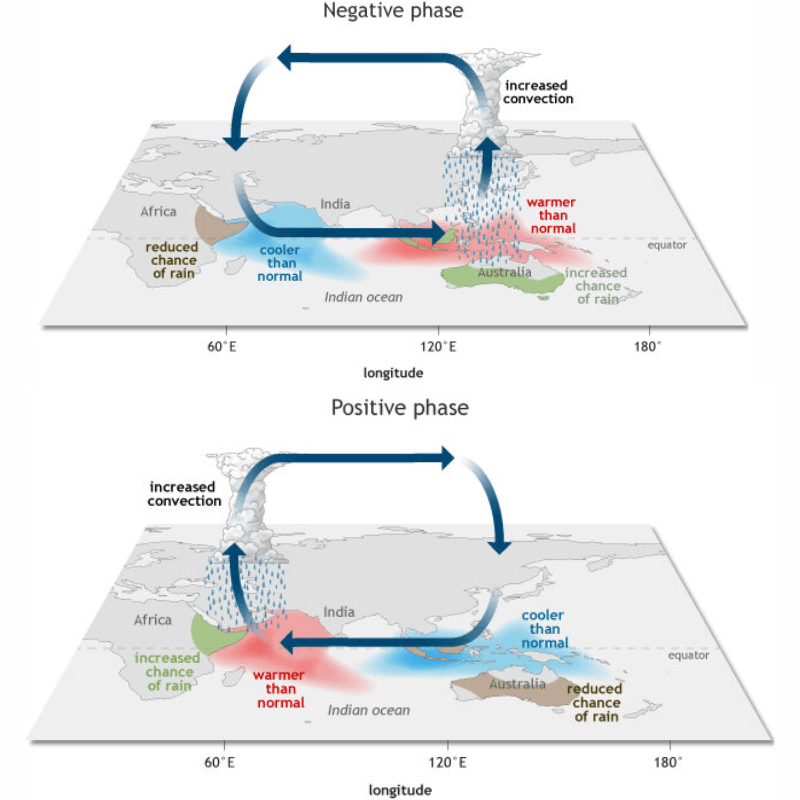Description

Context: The potential re-emergence of a positive Indian Ocean Dipole (IOD) or Indian Nino in the latter half of 2024 could impact India's monsoon patterns, potentially affecting rainfall distribution and agricultural outcomes across the country.
About Indian Ocean Dipole (IOD) or Indian Nino
- The Indian Ocean Dipole (IOD) is a climate phenomenon that occurs in the Indian Ocean and is characterised by anomalies in sea surface temperatures (SST) between different regions of the ocean.
- The IOD plays a significant role in influencing the climate and weather patterns in the Indian Ocean region and neighbouring land areas, including India, Southeast Asia, and East Africa.
The Indian Ocean Dipole is primarily driven by the following key factors:
Differential Heating
- Variations in the heating of the ocean surface between the western and eastern parts of the Indian Ocean play a crucial role in triggering the IOD.
- During certain phases, warmer waters accumulate in one region, while cooler waters dominate in another, leading to a temperature gradient across the ocean.
Atmospheric Interaction
- The interaction between the ocean and the overlying atmosphere, particularly atmospheric circulation patterns like the Walker Circulation, can influence the development and intensity of the IOD.
- Changes in atmospheric pressure and wind patterns affect the movement of ocean waters, contributing to SST anomalies.
|
The Walker Circulation is an east-west circulation of the atmosphere above the tropical Pacific, with air rising above warmer ocean parts (usually in the west) and sinking over cooler ocean areas (typically in the east). Its strength varies with that of the Southern Oscillation.
|

Phases of the IOD
- The Indian Ocean Dipole exhibits two primary phases, characterised by SST anomalies in different regions of the Indian Ocean.
Positive IOD Phase
- During a positive IOD phase, the western Indian Ocean experiences warmer-than-average sea surface temperatures (SSTs). Concurrently, cooler-than-average SSTs are observed in the eastern Indian Ocean.
- This positive temperature gradient leads to greater precipitation in the western Indian Ocean region.
- Positive IOD events often cause droughts in adjacent land areas of Indonesia and Australia due to reduced rainfall.
Negative IOD Phase
- A negative IOD phase is characterised by cooler-than-average SSTs in the western Indian Ocean. Warmer-than-average SSTs are observed in the eastern Indian Ocean during a negative IOD.
- This reversed temperature gradient compared to a positive IOD can impact weather patterns differently, affecting regional rainfall distribution and monsoon dynamics.

IOD Indicators
- Dipole Mode Index (DMI): The DMI is a commonly used index to quantify the temperature gradient (difference in SST anomalies) between the western and eastern parts of the Indian Ocean. A positive DMI indicates a positive IOD event, while a negative DMI signifies a negative IOD event.
- SST Anomalies: Monitoring sea surface temperature anomalies in specific regions of the Indian Ocean, such as the western pole (western equatorial Indian Ocean) and the eastern pole (eastern equatorial Indian Ocean), provides critical information about the presence and intensity of the IOD.
Effects of the IOD
- Effect on Southeast Asian and Australian Droughts: A positive IOD is associated with droughts in Southeast Asia and Australia. Extreme positive IOD events can exacerbate drought conditions.
- Impact on Rainfall across East Africa: A positive IOD is linked to higher-than-average rainfall during the East African Short Rains (EASR) season. Increased rainfall during a positive IOD can lead to flooding in East Africa, resulting in widespread destruction and loss of life.
- Interaction with El Niño: The IOD can influence the El Niño-Southern Oscillation (ENSO) phenomenon. IOD-induced surface wind anomalies can produce El Niño-like SST anomalies in the Pacific Ocean.
- Climate Change Influence: Climate change is expected to lead to more frequent and intense positive IOD events due to accelerated warming in the western Indian Ocean. This trend may further impact regional weather patterns and climate variability.
Source:
The Hindu
Wikipedia
|
PRACTICE QUESTION
Q. Consider the following statements regarding the Indian Ocean Dipole (IOD):
1. The Indian Ocean Dipole (IOD) phenomenon is also known as the "Indian Nino."
2. It has no significant impact on the monsoon rainfall over the Indian subcontinent.
3. It is primarily influenced by atmospheric changes rather than oceanic conditions.
4. A positive phase of the Indian Ocean Dipole (IOD) is associated with cooler sea surface temperatures in the eastern Indian Ocean.
How many of the above statements are correct?
A) Only one
B) Only two
C) Only three
D) All four
Answer: B
|
















